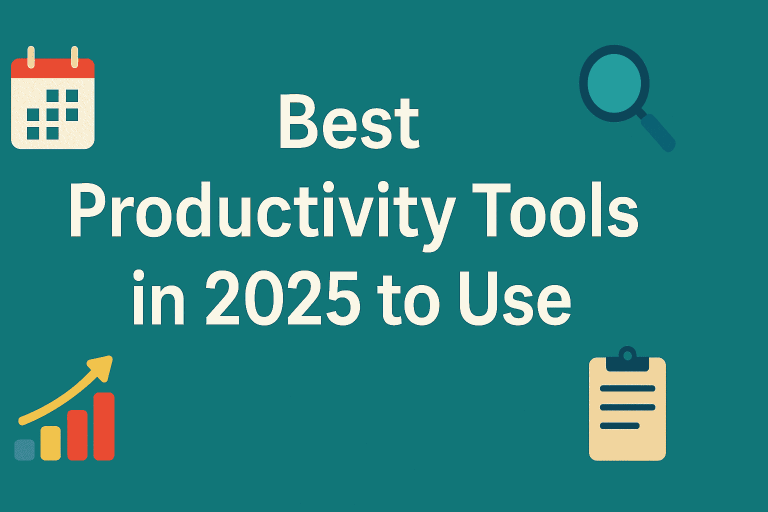Every year, I see new technologies come out that will allegedly “revolutionize productivity.” But come on — they’re mostly to-do lists with AI hats. In 2025, the biggest productivity tools are the ones that work behind the scenes, syncing with your life. They don’t fight for your attention. They earn it.
Whether I’m juggling a content flurry or alternating between calls to freelance clients, what makes a tool stand out today is no longer how many features it has but how little it requires me to think. If it reduces friction, it finds a home.
And no, I don’t mean for example taking an AI chatbot and dropping it into a calendar application and claiming it’s next-gen. The top-of-the-line productivity tools 2025 has to offer are lean, predictive, and spookily intelligent.
The Tools That Actually Make You Focus (Instead of Pretending To)
Here’s the thing they don’t tell you — a lot of what we call productivity is just emotional momentum. When that’s lost, no technology stack, no matter the price, will save you.
That’s why I started redefining what is a “productivity tool”. Ironically enough, it’s not necessarily your project board or note-taker. For example, services that assist you in having low social overhead indirectly make you 23% more focused on deep work — particularly when you’re developing online. Particularly because of this, I use services that offer followers for you to be productive. It’s one less thing that you need to seek out manually.
So your Notion dashboard might be neat, but the real question is whether your mind has room to think. And surprisingly, some of the ultimate productivity tools of 2025 aren’t “tools” in the traditional sense.
The Anti-Burnout Tech Stack You’ll Actually Use
Now for the good stuff, tools that have proven themselves over time after months of actual use. I’m referring to late nights, team pivots, blown deadlines, and that glorious moment when it all comes together.
- Motion: The self-organizing calendar that schedules itself according to your deadlines, tasks, and energy levels. It’s rather spooky the way it reads your day.
- Tana: It’s like you’re combining Notion and Roam and adding AI and then cleaning up the mess. You can create atomic notes, tag them, and turn chaos into clarity.
- XTiles: My non-linear brainstorming default. Linear notes simply aren’t going to work at the beginning of a creative project.
- ClickUp 3.0: Not perfect, perhaps, but for teams? Still among the most flexible task managers out there. I’ve onboarded interns to this and seen their ramp time shave days.
These are not just pretty dashboards. They are the actual top productivity tools 2025 has come up with after ten years of trying out various workflows.
Where Solo Operators and Teams Part Ways (Hard)
One of my largest early errors? Believing what works for me will work for my team. Not a good idea.
Being a solo creator, I found light tools like Todoist and Akiflow appealing. Fast. Bloat-free. But when I started working with others on long-term campaigns, I needed something that would be able to handle context: comments, attachments, timelines, dependencies.
For instance, I can personally manage five platforms alone but my team would be lost unless it was all at one place. That’s where platforms like Linear, Slite, and even Notion (yes, again) came back into the picture.
The best productivity tools 2025 will neatly fit into “for you” and “for the group.” And attempting to make one do the other is like putting your shoes on the wrong feet — you’ll move, but in agony.
Invisible AI: The Future of Getting Things Done
The hype around AI is not wearing off, but here is the truth: the tools that speak least about AI are using it the best.
I am beta testing something (under NDA, so sorry) that learns my working rhythm automatically and sets deep work sessions, without my needing to schedule anything. It learns my Slack habits, my use of the calendar, and how fast I reply to email. That is where we are headed.
We’re done with command-driven productivity. The productivity tools of 2025 that will watch, listen, and then help you without your permission. And you will love it.
Where Mobility Meets Mental Clarity
I actually planned out my entire week on a plane, with 4% battery and no Wi-Fi. That’s when I reassessed which tools are really necessary.
These Reclaim, Sunsama, and Sorted apps aren’t just “mobile-friendly.” They’re mobile-first, and it shows. They keep your priorities, keep you on track, and let you begin again on the go. Battery-saving modes, offline access, speedy gesture inputs – these are not premium features anymore. In 2025, leading productivity software is designed for motion, not meetings.
Don’t Build a Stack, Build an Immune System.
I will leave you with this, I stopped asking, “What’s the best productivity tool?” and began asking, “What’s slowing down my momentum?” That simple switch saved me hours a week.
If it’s ten clicks to look at something, throw it away. If it’s not going to sync between your devices or alert you when something goes wrong, it’s a liability.
In 2025, productivity isn’t about control anymore, it’s about resilience. The tools that flex, shield, and grow with your habits? Those are the ones you keep.
FAQs
What’s the most underrated productivity tool in 2025?
Tana. It’s quietly doing what most tools overpromise. Its structure lets you build custom workflows without needing templates or systems from others.
Are AI tools really helping or just adding complexity?
Depends. When used properly, AI tools automate tasks that drain your mental energy. But if you need to babysit them or train them daily, they become just another job.
How do I avoid jumping between too many productivity tools?
Audit what you use weekly. If a tool hasn’t improved your workflow or lightened your cognitive load in 14 days, it’s probably not worth keeping.


